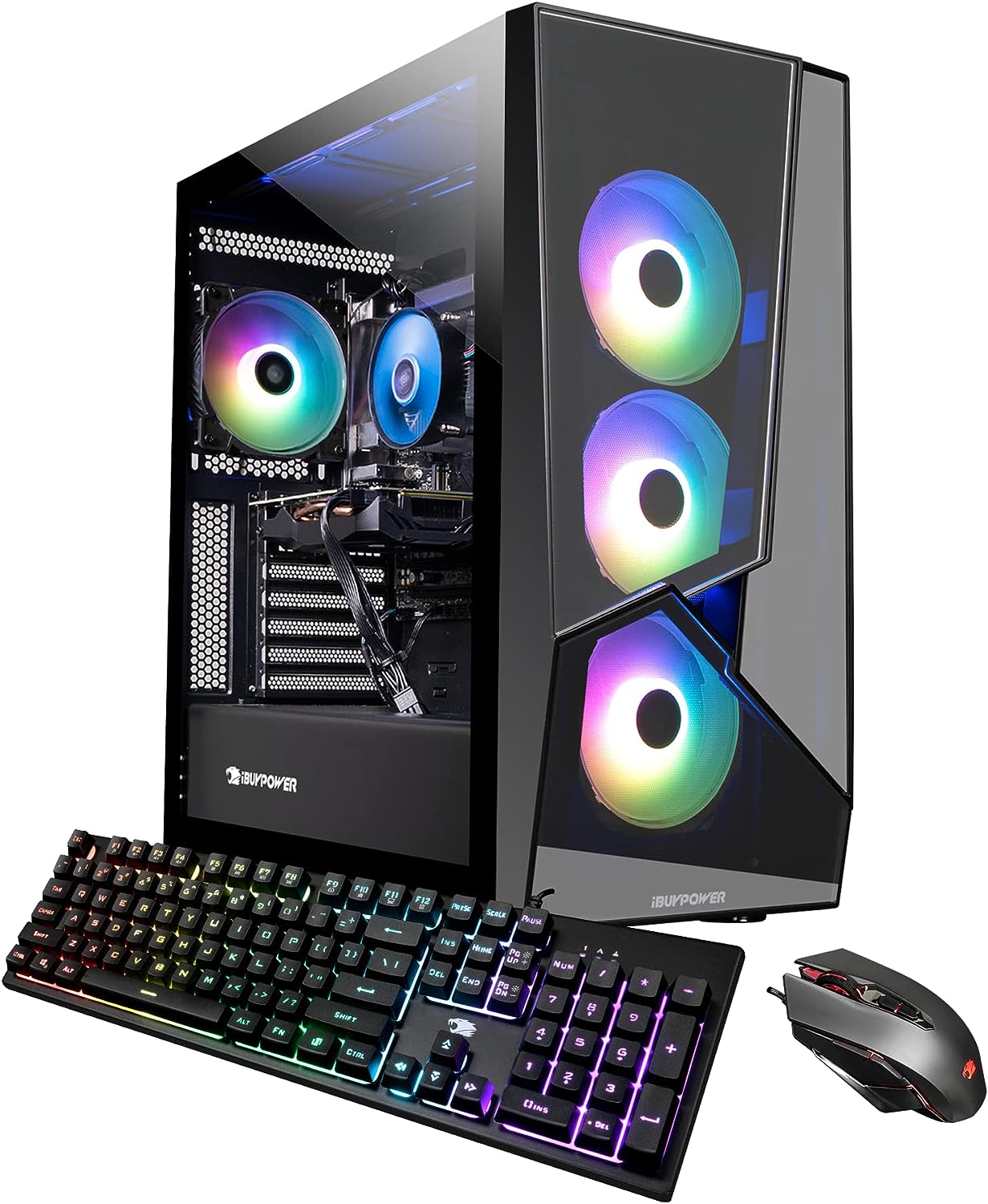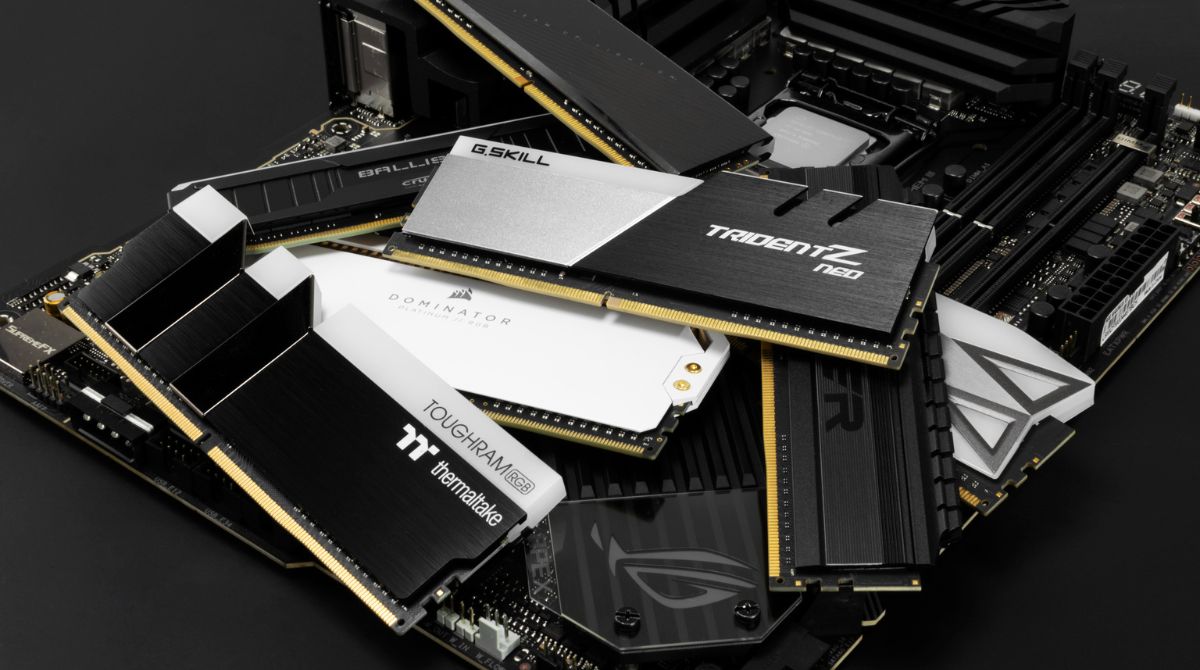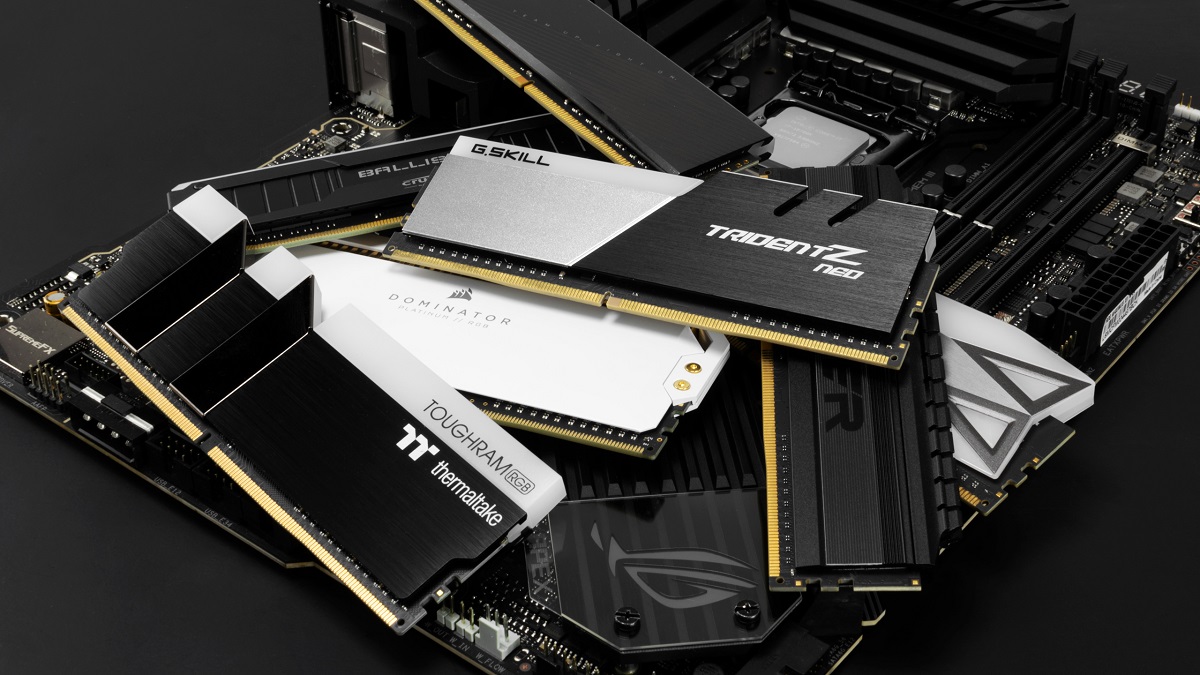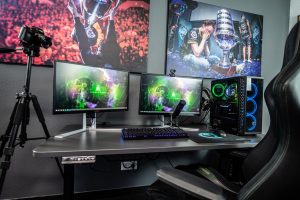Introduction
Welcome to the world of PC gaming! Whether you’re a avid gamer looking to upgrade your current setup or a newbie starting from scratch, one of the first questions you may have is, “How much is a PC for gaming?” Well, the answer can vary depending on various factors such as the level of performance you desire, the specific components you choose, and whether you opt for a pre-built system or build your own.
Gaming PCs are specifically designed to handle the graphics-intensive requirements of modern video games. They offer superior performance, faster processing speeds, and the ability to render stunning visuals in high resolution. Ultimately, the price of a gaming PC will depend on the level of performance you require and the quality of components you choose.
In this article, we will explore the different tiers of gaming PCs available on the market, from entry-level systems to high-end powerhouses. We’ll also delve into the benefits of custom-built PCs versus pre-built options, highlight key components like processors, graphics cards, RAM, and storage, and discuss other considerations such as gaming monitors, keyboards, mice, audio, and cooling.
Keep in mind that the budget you allocate for a gaming PC is entirely up to you. You can aim for a more modest setup that provides a decent gaming experience on a tight budget, or invest in a top-of-the-line rig for unparalleled performance. Regardless of your budget, we’ll provide you with all the information you need to make an informed decision.
So, get ready to dive into the exciting world of gaming PCs. Whether you’re a casual gamer or a competitive e-sports enthusiast, there’s a gaming PC out there that will meet your needs and take your gaming experience to a whole new level. Let’s explore how much a PC for gaming can cost and what factors you need to consider.
Minimum Requirements for Gaming PCs
Before delving into the cost and options available for gaming PCs, it’s important to understand the minimum requirements necessary to run modern games smoothly. While the specific requirements can vary depending on the game, there are some general guidelines to consider.
The processor, or CPU, is the brain of your gaming PC. To ensure smooth gameplay, a quad-core CPU with a clock speed of at least 3.0 GHz is recommended. Additionally, the graphics card, or GPU, is crucial for rendering high-quality graphics. A dedicated graphics card with a minimum of 4GB of VRAM is recommended for most modern games.
RAM, or memory, is another important consideration. For a gaming PC, a minimum of 8GB of RAM is recommended. This will allow for smooth multitasking and quick loading times. Storage is also essential, with most gamers opting for a combination of a Solid-State Drive (SSD) for faster boot times and an ample Hard Disk Drive (HDD) for storing games and files.
Furthermore, it’s vital to have a power supply that can handle the demands of your gaming PC. A power supply with a wattage of at least 500W is recommended to ensure stability and avoid any issues with power delivery. Additionally, a reliable motherboard with sufficient slots for expansion and a compatible socket for your CPU is crucial for building a gaming PC.
In terms of connectivity, a gaming PC should have USB 3.0 ports for faster data transfer, as well as an Ethernet port for a stable internet connection. For wireless connectivity, a Wi-Fi adapter or motherboard with built-in Wi-Fi capabilities is convenient.
It’s important to note that these are the minimum requirements for running games at lower settings. If you want to enjoy the latest games at higher graphics settings and resolutions, you may need to invest in more powerful components.
Now that we have an understanding of the minimum requirements, let’s explore the different tiers of gaming PCs available in the market.
Entry-Level Gaming PCs
Entry-level gaming PCs are a great option for gamers on a tight budget or those who are just starting their gaming journey. These systems offer decent performance at an affordable price point.
When it comes to the processor, entry-level gaming PCs typically feature mid-range options, such as the Intel Core i5 or AMD Ryzen 5. These CPUs provide enough power for most games without breaking the bank. Paired with a budget-friendly dedicated graphics card, like the NVIDIA GeForce GTX 1650 or AMD Radeon RX 570, entry-level gaming PCs can handle popular titles at 1080p resolution and medium settings.
In terms of RAM, entry-level gaming PCs usually come with 8GB, which is sufficient for most games. However, it’s a good idea to opt for systems that offer upgradeable RAM slots so you can easily increase the memory in the future if needed.
When it comes to storage, these systems often include a combination of a modest-sized SSD, typically around 256GB, for faster boot times and a larger HDD, ranging from 1TB to 2TB, for storing games and files.
Entry-level gaming PCs may not come with all the bells and whistles of higher-end models, but they still provide an enjoyable gaming experience for casual gamers or those on a budget. Additionally, these systems are often upgradeable, allowing you to improve performance in the future by adding more RAM, a better graphics card, or additional storage.
It’s worth noting that entry-level gaming PCs might not be able to handle the most demanding games at maximum settings and high resolutions. However, they are a great starting point for gamers who want to dip their toes into the world of PC gaming without breaking the bank.
In the next section, we’ll explore the next tier of gaming PCs: the mid-range options that offer a balance between price and performance.
Mid-Range Gaming PCs
If you’re looking for a gaming PC that offers a balance between performance and affordability, mid-range options are worth considering. These systems provide a significant step up from entry-level PCs, allowing for smoother gameplay and the ability to handle more demanding titles.
In terms of processors, mid-range gaming PCs typically feature higher-end options like the Intel Core i7 or AMD Ryzen 7. These CPUs offer more cores and higher clock speeds, resulting in improved overall performance. Combined with a mid-range graphics card, such as the NVIDIA GeForce GTX 1660 Ti or AMD Radeon RX 5600 XT, mid-range gaming PCs can handle games at 1080p or even 1440p resolution at medium to high settings.
When it comes to RAM, mid-range gaming PCs often come equipped with 16GB, which provides ample memory for multitasking and smoother gameplay. Storage options may include a faster and larger capacity SSD, such as 512GB or 1TB, allowing for quicker loading times and more space for games and applications. Additionally, a secondary HDD is usually included for additional storage needs.
Mid-range gaming PCs also tend to offer more connectivity options and features compared to entry-level systems. They may include additional USB ports, RGB lighting, and improved cooling solutions to ensure optimal performance during gaming sessions.
While mid-range gaming PCs offer better performance and more features than entry-level models, they might still fall short of handling the most demanding games at maximum settings and high resolutions. However, if you’re looking for a gaming PC that can handle most games at good settings without breaking the bank, a mid-range option is a solid choice.
In the next section, we’ll take a look at high-end gaming PCs that offer top-of-the-line performance for gamers who demand nothing but the best.
High-End Gaming PCs
For gamers who crave the ultimate gaming experience with no compromise on performance, high-end gaming PCs are the top choice. These systems are designed to deliver exceptional power, stunning visuals, and the ability to handle even the most demanding games at maximum settings and high resolutions.
High-end gaming PCs are equipped with top-of-the-line processors, such as the Intel Core i9 or AMD Ryzen 9. These CPUs offer the highest number of cores and clock speeds, allowing for unparalleled performance in gaming and other intensive tasks like video editing or 3D rendering.
The graphics card is the most critical component in a high-end gaming PC, and these systems come equipped with flagship models like the NVIDIA GeForce RTX 3080 or AMD Radeon RX 6900 XT. These top-tier graphics cards boast high VRAM capacity and advanced features like ray tracing and DLSS, delivering incredible visuals and smooth gameplay at 4K resolution or even higher.
In addition to the powerful CPU and graphics card, high-end gaming PCs feature a generous amount of RAM, often 32GB or more. This ensures seamless multitasking and allows for future-proofing as games continue to become more demanding. Storage options usually include larger SSDs, typically 1TB to 2TB in capacity, for lightning-fast loading times, and ample storage space for a vast library of games.
High-end gaming PCs also come with advanced cooling systems to keep the components running at optimal temperatures during intense gaming sessions. They may include liquid cooling solutions, multiple fans, and well-designed airflow systems to prevent overheating and ensure stability.
These high-performance machines often offer customizable RGB lighting, premium build quality, and extensive connectivity options. They are designed not only to deliver exceptional gaming performance but also to visually stand out and provide a premium gaming experience.
It’s worth noting that high-end gaming PCs come with a higher price tag compared to entry-level or mid-range options. However, if you’re a hardcore gamer, content creator, or simply want the best gaming experience money can buy, investing in a high-end gaming PC will undoubtedly provide an immersive and future-proof gaming setup.
Next, we’ll explore the option of custom-built gaming PCs and pre-built gaming PCs, allowing you to choose the best configuration that suits your needs and budget.
Custom-Built Gaming PCs
Custom-built gaming PCs offer the ultimate flexibility and control over your gaming setup. With a custom-built PC, you have the freedom to choose each component according to your specific needs and preferences, ensuring that every aspect of your system is tailored to deliver the best gaming experience.
One of the main advantages of building a custom gaming PC is the ability to handpick the components that best suit your requirements. You can select the exact processor, graphics card, RAM, storage, and other peripherals based on your gaming preferences, budget, and future upgradeability. This level of customization allows you to optimize your system for gaming performance, ensuring that you have the necessary power and capabilities to run the games you love.
Another advantage of custom-built gaming PCs is the ability to prioritize certain components over others. For example, if you’re more interested in graphics performance, you can allocate a larger portion of your budget to a high-end graphics card while compromising on other components that may not have as much impact on gaming performance.
In addition to component selection, building your own PC gives you the freedom to choose the aesthetic design and overall look of your system. You can opt for a sleek and minimalistic build or go all out with elaborate RGB lighting and custom water-cooling solutions. Customization extends beyond the internal components to the external appearance of your gaming PC, allowing you to express your personal style.
Building a custom gaming PC may require more technical knowledge and research compared to purchasing a pre-built system, but it offers a rewarding experience and the opportunity to learn about the intricacies of PC hardware. There are numerous online resources, tutorials, and communities that can assist you in the process of assembling your custom PC, making it accessible to both beginners and more experienced builders.
While custom-built gaming PCs offer unparalleled customization, they do require more time and effort to put together. It’s important to ensure compatibility between the selected components and consider factors such as power requirements and cooling solutions. However, for gamers who want complete control over their gaming experience and are willing to put in the effort, building a custom gaming PC is an excellent choice.
Now that we’ve explored custom-built gaming PCs, let’s move on to the option of pre-built gaming PCs and their advantages.
Pre-Built Gaming PCs
Pre-built gaming PCs offer a convenient and hassle-free option for gamers who may not have the technical expertise or time to build their own system. These ready-to-use setups come fully assembled and tested, allowing you to jump right into gaming without the need for any additional setup or configuration.
One of the main advantages of pre-built gaming PCs is convenience. Instead of spending time researching and selecting individual components, you can simply choose a pre-built system that meets your requirements and budget. Pre-built gaming PCs are often available in a range of configurations, catering to different gaming needs, from entry-level systems to high-end gaming rigs.
Another benefit of pre-built gaming PCs is the assurance of compatibility and reliability. With pre-built systems, all the components are carefully selected and tested to ensure they work together seamlessly. The manufacturers also provide warranty and support, allowing for easy resolution in case of any hardware issues that may arise.
Pre-built gaming PCs often come with additional features and perks, such as pre-installed software, RGB lighting, and optimized cooling solutions. These systems are designed with gaming in mind and may include special enhancements, like manufacturer-specific software for overclocking, advanced cooling mechanisms, and efficient cable management.
Aside from the convenience and reliability, pre-built gaming PCs can also offer good value for money. Manufacturers often have partnerships with component suppliers, allowing them to offer competitive pricing on the systems they build. Additionally, purchasing a pre-built system may be more cost-effective than purchasing individual components separately and assembling them yourself.
While pre-built gaming PCs come with numerous benefits, customization options may be limited compared to custom-built systems. However, many manufacturers do offer the ability to choose certain components, such as the graphics card or storage capacity, to tailor the system to some extent.
Ultimately, pre-built gaming PCs are a great option for gamers who want a hassle-free and reliable gaming experience. They offer convenience, compatibility, and customer support, all while providing excellent gaming performance out of the box.
Now that we’ve explored pre-built gaming PCs, let’s move on to the topic of upgrading your current PC for gaming and the options available.
Upgrading Your Current PC for Gaming
If you already have a PC but it’s not specifically optimized for gaming, fear not! You have the option to upgrade your current system to meet the requirements of modern games and enhance your gaming experience.
One of the first areas to consider when upgrading your PC for gaming is the graphics card. A more powerful graphics card can greatly improve gaming performance and allow you to play newer, more demanding games. Look for a graphics card that fits within your budget and offers a significant performance boost compared to your current card.
Another crucial component to consider is the RAM. Increasing your RAM capacity can improve overall system performance and allow for smoother gameplay by reducing loading times and providing better multitasking capabilities. Aim for at least 8GB of RAM for optimal gaming performance, although 16GB is becoming the standard for most modern games.
If your current storage solution is holding you back, upgrading to a Solid-State Drive (SSD) can significantly enhance your gaming experience. An SSD offers faster boot times and quicker loading times for games, resulting in shorter wait times and a more enjoyable gaming session.
Other components that can be upgraded to boost gaming performance include the CPU and power supply. However, these upgrades may require more technical knowledge and compatibility considerations, so it’s important to research and ensure that the new components are compatible with your current system.
Before upgrading any component, it’s crucial to consider the compatibility of the new parts with your current system, as well as the power requirements and any potential bottlenecking issues. It’s also important to ensure that your current PC has sufficient ventilation and cooling, as upgraded components may generate more heat.
When it comes to upgrading your current PC for gaming, it’s worth noting that there may be limitations to how much you can upgrade depending on the age and specifications of your system. In some cases, it may be more cost-effective to invest in a new gaming PC or consider a hybrid solution where you upgrade some components while keeping others.
Regardless of the upgrades you choose, it’s important to research and carefully select the components based on your budget, gaming needs, and compatibility with your current system. Upgrading your current PC for gaming can be a cost-effective way to improve performance and enhance your gaming experience without starting from scratch.
Now that we’ve explored the options for upgrading your current PC, let’s delve into the important considerations when choosing the right processor for gaming.
Choosing the Right Processor for Gaming
When it comes to gaming, the processor, or CPU (Central Processing Unit), plays a crucial role in determining the overall performance of your gaming PC. It is responsible for executing the instructions and calculations needed to run games smoothly and handle other tasks.
When choosing a processor for gaming, there are several factors to consider. One of the primary considerations is the number of cores and threads. The more cores a processor has, the more tasks it can handle simultaneously. For gaming, a quad-core processor or higher is recommended, as many modern games are optimized for multiple cores.
In addition to the number of cores, the clock speed of the processor is a vital factor. Clock speed refers to the number of cycles a processor can execute per second, measured in GHz. A higher clock speed generally results in faster processing, which can lead to smoother gameplay and shorter loading times.
However, it’s important to note that clock speed alone is not the sole determinant of a processor’s performance. The architecture, cache size, and other technical specifications also play a significant role in overall performance. Therefore, it’s advisable to consider benchmarks and reviews to get an accurate assessment of a processor’s gaming capabilities.
Another aspect to consider when choosing a processor for gaming is compatibility. Ensure that the processor you are considering is compatible with your motherboard’s socket type. This information can usually be found in the motherboard’s specifications or documentation.
Lastly, budget is a crucial factor to consider when choosing a processor. Processors range in price from budget-friendly options to high-end models. It’s important to strike a balance between performance and budget, selecting a processor that meets your gaming needs without exceeding your financial constraints.
Some popular processors for gaming include the Intel Core i5 and i7 series, as well as AMD Ryzen 5 and Ryzen 7 series. These processors offer a good balance of performance and affordability, making them suitable for most gamers.
Ultimately, the right processor for gaming depends on your specific gaming needs, budget, and compatibility with your system. It’s advisable to research and read reviews to make an informed decision. Remember that the processor is just one component of a gaming PC, and achieving optimal gaming performance requires a well-rounded system with other important components like the graphics card and RAM.
Next, let’s explore another critical component for gaming PCs: selecting the best graphics card.
Selecting the Best Graphics Card for Gaming
When it comes to gaming, the graphics card, or GPU (Graphics Processing Unit), is arguably the most important component in a gaming PC. It is responsible for rendering and displaying the visuals of games, making it crucial in providing an immersive and smooth gaming experience.
When selecting a graphics card for gaming, there are several factors to consider. The first is the GPU’s performance, which is determined by factors such as core count, clock speed, memory bandwidth, and VRAM (Video Random Access Memory) capacity. Higher-performing GPUs typically offer better frame rates, improved visual quality, and the ability to handle more visually demanding games.
It’s important to note that the best graphics card for gaming may depend on the specific games you play and the resolution you play them at. Different games have varying requirements, and some may be more graphics-intensive than others. Additionally, if you plan to game at higher resolutions like 1440p or 4K, you’ll want a more powerful graphics card to ensure smooth gameplay.
Another consideration when choosing a graphics card is the brand and model. Both NVIDIA and AMD offer a range of graphics cards suitable for gaming. Popular options from NVIDIA include the GeForce RTX series, while AMD offers the Radeon RX series. It’s important to research and read reviews to determine which specific model within each brand offers the best performance and value for your gaming needs.
In addition to performance, compatibility is a crucial factor. Ensure that the graphics card you choose is compatible with your motherboard’s PCIe (Peripheral Component Interconnect Express) slot and fits within your power supply’s wattage capacity. It’s also important to consider the physical size of the card and whether it will fit properly in your PC case.
Finally, budget is a significant consideration when selecting a graphics card. Graphics cards range in price from budget-friendly options to high-end models. It’s essential to assess your budget and determine the level of gaming performance you desire, striking a balance between cost and performance. It’s worth noting that investing more in a higher-end graphics card can provide better longevity as games become more visually demanding in the future.
Ultimately, selecting the best graphics card for gaming involves balancing factors such as performance, compatibility, and budget. It’s advisable to research and consider the specific gaming requirements of the titles you intend to play, as well as future-proofing your system to some extent. By choosing a graphics card that offers excellent performance and fits your gaming needs, you’ll be well on your way to experiencing stunning visuals and smooth gameplay.
Next, let’s explore the amount of RAM needed for optimal gaming performance.
Determining the Right Amount of RAM for Gaming
RAM (Random Access Memory) is an essential component in a gaming PC as it directly affects the performance and responsiveness of your system. Having the right amount of RAM ensures smooth multitasking, faster load times, and optimal gameplay. When determining the right amount of RAM for gaming, several factors come into play.
The minimum amount of RAM recommended for gaming is generally 8GB. This is sufficient for running most games at acceptable performance levels. However, in recent years, game requirements have been increasing, and many new titles recommend 16GB of RAM for optimal performance. With 16GB of RAM, you can expect smoother gameplay, reduced stuttering, and improved overall system responsiveness.
It’s worth noting that the amount of RAM you need also depends on your gaming habits outside of gaming itself. If you like to run multiple applications or have numerous browser tabs open while gaming, having additional RAM can greatly improve your multitasking experience.
If you’re a content creator or engage in more demanding tasks alongside gaming, such as video editing or streaming, you may want to consider 32GB of RAM or even higher. These higher amounts of RAM ensure that your system can handle the demands of both gaming and resource-intensive applications simultaneously.
An additional factor to consider is the type of games you play. Some games have higher RAM requirements, especially open-world titles or games with large maps or complex simulations. If you frequently play these types of games, having more RAM can provide a smoother experience and reduce potential memory-related bottlenecks.
It’s important to keep in mind that RAM alone cannot compensate for deficiencies in other components like the CPU or graphics card. It works in conjunction with these other components to deliver optimal gaming performance. Therefore, it’s essential to have a well-rounded system that includes a capable processor and a powerful graphics card alongside sufficient RAM.
In summary, the recommended amount of RAM for gaming has evolved over the years. While 8GB of RAM is still the minimum requirement for most games, 16GB has become the standard for optimal gaming performance. However, if you engage in multitasking, content creation, or play more demanding games, you may want to consider 32GB of RAM or higher.
Next, let’s explore the different storage options available for gaming PCs.
Storage Options for Gaming PCs
Storage is a vital component in any gaming PC, as it affects loading times, game installations, and overall system performance. When it comes to storage options for gaming PCs, there are two main types to consider: Solid-State Drives (SSD) and Hard Disk Drives (HDD).
SSDs provide faster read and write speeds compared to HDDs, resulting in significantly quicker boot times, faster game loading, and better overall system responsiveness. They are ideal for storing your operating system, frequently played games, and applications that require fast access to data. SSDs come in various capacities, ranging from 128GB up to multiple terabytes, allowing ample space for your gaming library.
HDDs, on the other hand, offer larger storage capacities at a lower cost per gigabyte. They are well-suited for storing less frequently accessed games, media files, and applications that do not require rapid loading times. While HDDs are slower in terms of read and write speeds compared to SSDs, they remain a cost-effective option for additional storage needs. HDD capacities can range from a few hundred gigabytes to multiple terabytes, providing ample space for extensive game collections.
Many gaming enthusiasts opt for a combination of SSD and HDD storage for the best of both worlds. By installing the operating system and frequently played games on an SSD, you can benefit from faster game loading and quicker system responsiveness. Simultaneously, using an HDD for storing less frequently accessed games and media files allows for more cost-effective storage at greater capacities.
It’s worth noting that newer advancements, such as NVMe M.2 SSDs, offer even faster speeds compared to traditional SATA SSDs. NVMe M.2 drives connect directly to the motherboard via a PCIe slot, bypassing the SATA interface and providing lightning-fast read and write speeds.
When selecting storage for your gaming PC, consider the number and size of games you plan to install, as well as your budget. Aim for a fast and reliable SSD for your primary storage needs, and supplement it with an HDD if you require additional storage space. Additionally, consider the future growth of your gaming library and budget for ample storage capacity to accommodate new releases and updates.
In summary, SSDs provide faster performance and quicker loading times, making them ideal for the operating system and frequently played games. HDDs offer larger storage capacities at a lower cost per gigabyte, making them suitable for storing less frequently accessed games and media files. Ultimately, a combination of SSD and HDD storage provides the best balance between speed and cost-effective storage for your gaming PC.
Next, let’s explore the importance of selecting a gaming monitor that complements your gaming experience.
Choosing a Gaming Monitor
A gaming monitor is a crucial component of any gaming setup, as it directly impacts your visual experience and gameplay. When it comes to choosing a gaming monitor, there are several factors to consider to ensure you get the best display for your gaming needs.
The first consideration is the screen size and resolution. Larger screens offer a more immersive gaming experience, while smaller screens are more compact and space-efficient. As for resolution, a higher resolution, such as 1440p or 4K, provides sharper and more detailed visuals, but keep in mind that it requires a more powerful graphics card to drive those resolutions effectively.
Refresh rate is another critical factor in a gaming monitor. It refers to the number of times the screen refreshes per second and is measured in Hertz (Hz). A higher refresh rate, such as 144Hz or 240Hz, allows for smoother motion and reduces motion blur, resulting in a more fluid gaming experience. However, it’s worth noting that a higher refresh rate requires a more powerful graphics card to achieve optimal performance.
Response time is the time it takes for a pixel to transition from one color to another. A lower response time, typically measured in milliseconds (ms), means faster transitions and reduces ghosting or blurring during fast-paced gaming. Aim for a monitor with a response time of 5ms or lower for optimal gaming performance.
Another feature to consider is adaptive sync technology, such as NVIDIA G-SYNC or AMD FreeSync. These technologies synchronize the refresh rate of the monitor with the frame rate produced by the graphics card, resulting in smoother gameplay, reduced screen tearing, and improved overall visual quality. Ensure that the monitor you choose is compatible with your graphics card’s adaptive sync technology.
Connectivity options are also important to consider, especially if you plan to connect multiple devices to your monitor. Look for a monitor with sufficient HDMI or DisplayPort inputs to accommodate your gaming PC, gaming consoles, and other peripherals.
Finally, consider the ergonomic features of the monitor. A monitor with height adjustment, tilt, and swivel capabilities allows for a more comfortable viewing experience during long gaming sessions. Additionally, features like an adjustable stand or VESA mount compatibility provide flexibility in positioning the monitor to suit your preferences.
Ultimately, when choosing a gaming monitor, consider the screen size, resolution, refresh rate, response time, adaptive sync technology, connectivity options, and ergonomic features. It is important to find the right balance between these factors based on your gaming preferences and budget.
Now that we’ve covered gaming monitors, let’s explore the importance of gaming keyboards and mice in enhancing your gaming experience.
Gaming Keyboard and Mouse Options
When it comes to gaming, having the right keyboard and mouse can greatly enhance your gaming experience, providing comfort, precision, and responsiveness. Gaming keyboards and mice are specifically designed with features that cater to the needs of gamers. Here are some factors to consider when selecting your gaming peripherals.
Gaming Keyboards:
– Key Switches: Key switches determine the feel, actuation point, and noise level of the keys. Mechanical switches are the most popular choice for gaming due to their tactile feedback and durability. Common switch types include Cherry MX, Razer Green, and Logitech Romer-G.
– Backlighting: Many gaming keyboards feature customizable backlighting options, allowing you to personalize the lighting effects to match your gaming setup. RGB lighting, in particular, offers a wide range of color options and effects.
– Programmable Keys: Gaming keyboards often come with programmable keys that can be customized to perform specific functions or macros, providing quick access to in-game commands.
– Ergonomics: Look for gaming keyboards with an ergonomic design and wrist rest for improved comfort during long gaming sessions.
Gaming Mice:
– DPI (Dots Per Inch): DPI refers to the sensitivity of the mouse. A higher DPI allows for faster cursor movement, which can be beneficial in fast-paced gaming. Look for a gaming mouse with adjustable DPI settings to suit different gaming scenarios.
– Programmable Buttons: Gaming mice often feature programmable buttons that can be configured for specific in-game functions or macros. These extra buttons provide quick access to commands, giving you a competitive edge.
– Ergonomics: Comfort is crucial during gaming sessions, so opt for a gaming mouse with a design that fits your hand size and grip style. Some mice offer grips or customizable weight options for added comfort and precision.
– Sensor Type: The type of sensor in a gaming mouse can affect tracking accuracy. Optical sensors are common and provide precise tracking on most surfaces, while newer mice may feature laser sensors for even more accurate tracking.
– Customization Software: Look for gaming mice that come with software that allows you to customize settings, such as button assignments, DPI levels, lighting effects, and polling rates.
Remember to test out different keyboards and mice if possible to find the ones that feel most comfortable and responsive for you. Personal preference plays a significant role in the selection process, so choose peripherals that suit your gaming style and preferences.
Now that we’ve explored gaming keyboards and mice, let’s move on to considering audio options for your gaming PC.
Audio Considerations for Gaming PCs
Audio plays a crucial role in gaming, enhancing immersion and providing important auditory cues. When it comes to audio considerations for gaming PCs, there are several factors to keep in mind to ensure an optimal gaming experience.
Headsets:
– Audio Quality: Look for gaming headsets that offer high-quality audio, with clear and accurate sound reproduction. Headsets with virtual surround sound can provide immersive 3D audio, enhancing your ability to locate and track in-game sounds.
– Comfort and Fit: Gaming headsets should be comfortable to wear for extended gaming sessions. Look for headsets with adjustable headbands, cushioned ear cups, and lightweight designs.
– Microphone Quality: If you engage in multiplayer gaming or communicate with teammates, a headset with a high-quality microphone is essential. Look for headsets with noise-canceling microphones that provide clear and crisp voice communication.
Speakers:
– Audio Output: High-quality speakers can provide a more immersive gaming experience, especially for games with dynamic sound design. Look for speakers that deliver rich audio with good frequency response and sufficient power output.
– Surround Sound: Some gaming speakers offer surround sound capabilities, providing a more accurate soundstage and positional audio for a competitive advantage in games.
– Space and Size: Consider the available space and the size of the speakers when choosing a speaker system for your gaming PC. Compact bookshelf speakers or desktop speakers may be suitable for smaller setups, while larger floor-standing speakers can provide a powerful and immersive audio experience.
Sound Cards and Audio Interfaces:
– Sound Quality: Upgrading your sound card or investing in an external audio interface can enhance the audio quality of your gaming setup. Look for options that offer high-resolution audio and support for surround sound formats.
– Connectivity: Consider the connectivity options of the sound card or audio interface to ensure compatibility with your gaming PC and other audio devices.
– Sampling Rates and Bit Depths: Higher sampling rates and bit depths can provide improved audio fidelity and accuracy, resulting in better audio reproduction during gaming sessions.
Whether you choose a gaming headset, speakers, or upgrade your sound card, audio considerations are essential for a truly immersive gaming experience. Test out different audio options if possible and look for reputable brands known for their audio quality.
In the next section, we’ll explore the importance of cooling and overclocking for gaming PCs.
Cooling and Overclocking
Cooling and overclocking are two important considerations for gaming PCs to ensure optimal performance and prevent overheating. Proper cooling mechanisms and the ability to overclock components can enhance gaming performance and extend the lifespan of your hardware. Let’s delve into these topics:
Cooling:
– Air Cooling: Most gaming PCs use air coolers, which consist of fans and heat sinks to dissipate heat generated by the CPU and GPU. Ensure that your gaming PC has sufficient airflow with strategically placed intake and exhaust fans to maintain low operating temperatures.
– Liquid Cooling: Liquid cooling systems, such as all-in-one (AIO) coolers or custom water-cooling setups, offer more efficient cooling compared to air cooling. They use liquid or coolant to transfer heat away from the components, resulting in lower temperatures and improved performance. Liquid cooling is especially beneficial for high-performance systems or when overclocking.
– Case Design: Opt for a gaming PC case that provides ample airflow and accommodates the cooling components you plan to use. Look for cases with dust filters, adequate fan mounts, and cable management options to enhance airflow and keep your system clean.
– Thermal Paste: Thermal paste is used to enhance heat transfer between the CPU or GPU and the cooling solution. Applying high-quality thermal paste correctly can improve cooling performance, reducing overall temperatures and preventing overheating.
Overclocking:
– CPU and GPU: Overclocking is the process of increasing the clock speeds of the CPU and GPU beyond their default settings, resulting in higher performance. However, overclocking generates more heat, so proper cooling is essential to maintain stable operation. It’s important to research and understand the potential risks and limitations of overclocking before attempting it.
– Overclocking Software: Many gaming motherboards and graphics cards come with software utilities that allow for easy and safe overclocking. These utilities provide control over clock speeds, voltages, and fan speeds, making it simpler to fine-tune your system while monitoring temperatures and stability.
– Stability Testing: After overclocking, it’s crucial to stress-test your system using software like Prime95 or FurMark to ensure stability and prevent crashes. Keep an eye on temperatures during stress testing and adjust clock speeds or voltages as necessary to maintain stable operation.
– Warranty Considerations: Overclocking your hardware may void the warranty, so it’s important to check the warranty terms before proceeding. Some manufacturers offer overclocking-friendly warranties, while others may have specific limitations or require additional coverage for overclocked systems.
Cooling and overclocking go hand in hand when it comes to pushing the limits of gaming performance. Proper cooling ensures longevity and stability while overclocking can unleash the full potential of your components. However, always prioritize safety, research extensively, and consider expert advice when venturing into overclocking.
In the next section, we’ll address budgeting considerations for a gaming PC and provide some tips for achieving the best value for your money.
Budgeting for a Gaming PC
When it comes to building or buying a gaming PC, budgeting is an important consideration. It’s essential to determine the amount you’re willing to spend and allocate your budget wisely to ensure the best value for your money. Here are some budgeting considerations for a gaming PC:
Define Your Budget: Determine the maximum amount you’re comfortable spending on your gaming PC. Consider factors such as your gaming needs, desired performance level, and any other peripherals or accessories you’ll need.
Focus on Key Components: Prioritize your budget on the key components that have the most significant impact on gaming performance. This typically includes the processor, graphics card, and RAM. Allocate a larger portion of your budget to these components to ensure a smooth gaming experience.
Research and Compare Prices: Before making any purchases, research the prices of components from different vendors and compare deals to find the best price-performance ratio. Keep an eye out for sales, discounts, and promotional offers that can help you maximize your budget.
Consider Future Upgradability: When budgeting, consider the potential for future upgrades. Investing in a higher-end motherboard, power supply, or case with room for expansion can save you money in the long run, as you’ll have the flexibility to upgrade individual components without replacing the entire system.
Find the Right Balance: It’s important to strike a balance between your budget and your desired gaming performance. While it’s tempting to want the latest and most powerful components, consider the actual requirements of the games you play and choose components accordingly. Remember, technology advances rapidly, and even mid-range components can offer excellent gaming performance at a more affordable price point.
Consider Pre-Built vs. Custom-Built: Decide whether building your own gaming PC or purchasing a pre-built system fits your budget and needs. Pre-built systems may be more convenient, but they often come at a premium. Building your own PC allows for greater customization and potential cost savings, but it requires research and technical knowledge.
Factor in Other Peripherals and Accessories: Don’t forget to budget for additional accessories such as a gaming monitor, keyboard, mouse, audio equipment, and storage solutions. Consider the features you need without overspending on unnecessary extras.
Plan for Longevity: Consider the longevity of your gaming PC and the potential need for future upgrades or replacements. Investing a bit more upfront in higher-quality components may provide a longer-lasting and more satisfying gaming experience, saving you money in the long term.
By budgeting effectively, comparing prices, and finding the right balance between performance and cost, you can build or buy a gaming PC that fits your budget while delivering an enjoyable gaming experience. Always do your research and consider expert advice to make informed decisions.
In the next section, we’ll wrap up our discussion and summarize the key points covered.
Conclusion
Building or buying a gaming PC can be an exciting and rewarding endeavor, and understanding the key factors involved can help you make informed decisions. From determining your budget to selecting the right components and peripherals, each step contributes to creating a gaming setup that meets your needs and provides an immersive gaming experience.
We explored the different tiers of gaming PCs, from entry-level systems to high-end powerhouses, highlighting the benefits and considerations for each. Custom-built PCs offer flexibility and customization options, while pre-built systems offer convenience and reliability. Upgrading your current PC can be a cost-effective option, allowing you to improve performance without starting from scratch.
Key components such as the processor, graphics card, RAM, and storage were discussed in detail, along with considerations for gaming monitors, keyboards, mice, audio, cooling, and overclocking. We also stressed the importance of budgeting wisely, finding the right balance between cost and performance, and considering future upgradability.
By making informed decisions based on your gaming needs, budget, and personal preferences, you can build or buy a gaming PC that offers an immersive gaming experience, smooth performance, and longevity. Remember to consider compatibility, research prices, and take advantage of sales and promotions to maximize the value of your investment.
Whether you’re a casual gamer or a dedicated enthusiast, the world of gaming PCs offers a multitude of options and possibilities. Take the time to explore, learn, and experiment to find the setup that suits you best, and remember to have fun along the way.

























